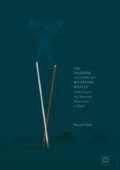Abstract
This chapter gives a brief background of the subject matter and defines the scope of the subject to be examined in this book. It then offers a literature review of previous studies of Japanese whaling, which demonstrates the paucity of studies of Japanese whaling culture in general and of memorial rites for whales in particular, and thus demonstrates the significance of this book.
In nature one form of life must always prey upon another. However, human consciousness holds an awareness of, and sympathy for, the will of other beings to live. An ethical human strives to escape from this contradiction so far as possible.
—Reverence for Life, Albert Schweitzer (1923)
Notes
- 1.
“Whaling in the Antarctic (Australia v. Japan: New Zealand intervening),” March 31, 2014, http://www.icj-cij.org/docket/files/148/18136.pdf
- 2.
Ibid.; Isao Miyaoka, “State-Society Relations Under Foreign Pressure: Two Contrasting Cases in the Japanese Fisheries Policy,” http://www.dijtokyo.org/doc/dij-jb_11-miyaoka.pdf, downloaded February 24, 2016. For details of gaiatsu (foreign pressure) politics, see Kent E. Calder, “Japanese Foreign Economic Policy Formation: Explaining the Reactive State,” World Politics, Vol. 40, No. 4, July 1988, 517–541.
- 3.
Miyaoka; Ian Hurd, “Almost Saving Whales: The Ambiguity of Success at the International Whaling Commission,” March 29, 2012, http://www.ethicsandinternationalaffairs.org/2012/almost-saving-whales-the-ambiguity-of-success-at-the-international-whaling-commission-full-text/
- 4.
Nakazono Shigeo and Yasunaga Hiroshi, Kujira-tori e-monogatari (Picture Tales of Whaling), Fukuoka: Gen-shobō, 2009, 8–20; Kumano Taiji-ura hogei-shi hensan-iinkai, ed., Kumano no Taiji: Kujira ni idomu machi (Taiji, Kumano: Town That Challenges Whales), Tokyo: Heibonsha, 1965, 4–16.
- 5.
Ibid. (both).
- 6.
Boreal Institute for Northern Studies, ed., Small-Type Coastal Whaling i00n Japan: Report of an International Workshop, Edmonton, Alberta: Boreal Institute for Northern Studies, the University of Alberta, 1988, 53–54.
- 7.
Peter J. Stoett, The International Politics of Whaling, Vancouver: UBC Press, 1997; Arne Kalland, Unveiling the Whale: Discourse on Whales and Whaling, New York: Berghan Books, 2009; D. Graham Burnett, Trying Leviathan: The Nineteenth-Century New York Court Case That Put the Whale on Trial and Challenged the Order of Nature, Princeton, N.J.: Princeton University Press, 2007 and The Sounding of the Whale: Science and Cetaceans in the Twentieth Century, Chicago, IL: University of Chicago Press, 2012; Arne Kalland and Brian Moeran, Japanese Whaling: End of an Era, London: Curzon Press, 1992; Jun Morikawa, Whaling in Japan: Power, Politics, and Diplomacy, New York: Columbia University Press, 2009.
- 8.
Arne Kalland, “Japanese Perceptions of Whales and Dolphins,” in John Knight, ed., Wildlife in Asia: Cultural Perspectives. London: RoutledgeCurzon, 2004, 73–87; Jessamyn R. Abel, “The Ambivalence of Whaling: Conflicting Cultures in Identity Formation,” in George M. Pflugfelder and Brett L. Water, eds., JAPANimals: History and Culture in Japan’s Animal Life, Ann Arbor, MI: Center for Japanese Studies, University of Michigan, 2005, 315–340.
- 9.
Boreal Institute for Northern Studies, ed., “Whaling Beliefs and Japanese Worldview,” 52–65; Barbara R. Ambros, Bones of Contention: Animals and Religion in Contemporary Japan, Honolulu: University of Hawai‘i Press, 2012, 57–62.
- 10.
Kumi Kato, “Prayers for the Whales: Spirituality and Ethics of a Former Whaling Community—Intangible Cultural Heritage for Sustainability,” International Journal of Cultural Property (2007), No. 14, 283–313.
- 11.
“Kujira: Nihon no koshiki-hogei to zusetsu” (Whales: Japanese Classical Whaling and Illustrations), 2011, http://www.lib.u-tokyo.ac.jp/tenjikai/tenjikai2011/kujira.html
- 12.
Fukumoto Kazuo, Nihon hogeishi-wa (History of Japanese Whaling), Tokyo: Hōsei daigaku-shuppankai, 1960; Hirado-shi kyōiku-iinkai, ed., Saikai geigei-ki (Record of Whaling in the West Sea), Hirado: Hirado-shi kyōiku-iinkai, 1980; Akimichi Tomoya, Kujira to hito no minzoku-shi (Ethnography of Whales and People), Tokyo: Tokyo daigaku-shuppankai, 1994; Morita Katsuaki, Kujira to hogei no bunka-shi (Cultural History of Whales and Whaling), Nagoya: Nagoya-daigaku-shuppankai, 1994; Nakazono Shigeo, Kujira-tori no keifu: Gaisetsu Nihon hogei-shi (Genealogy of Whaling: Introduction to the History of Japanese Whaling), Nagasaki: Nagasaki Shimbunsha, 2001; Ohsumi, Seiji, Kujira to Nihonjin (Whales and the Japanese), Tokyo: Iwanami-shinsho, 2003; Komatsu Masayuki, Kujira sono rekishi to bunka (History and Culture of Whales), Tokyo: Goma-shobō, 2005; Nakazono and Yasunaga.
- 13.
Watanabe Hiroyuki, Hogei-mondai no rekishi shakaigaku: Kingendai Nihon ni okeru kujira to ningen (Historical Sociology of Whaling Problems: Whales and People in Modern Japan), Tokyo: Tōshindō, 2006.
- 14.
Shindō Naosaku, Seto-naikai no kujira no kenkyū (Study of Whales in the Inland Sea). Kobe: Kobe-shi ishi-kyōdo-kumiai, 1968 and Seto-naikai shūhen no kujira no kenkyū (Study of Whales Surrounding the Inland Sea), Kobe: Ikuta-ku ishikai, 1970; Yoshihara Tomokichi, “Kujira no haka” (Graves of Whales), in Tanigawa Ken’ichi, ed., Nihon minzoku bunka shiryō shūsei (Collection of Documents on Japanese Folk Culture), Vol. 18, Tokyo: San’ichi-shobō, 1997, 409–478.
- 15.
Yoshihara.
- 16.
Taiji-chōritsu kujira no hakubutsukan, ed., Kujira-bune: Katachi to ishō (Whale Boats: Styles and Designs), Taiji: Taiji-chōritsu kujira no hakubutsukan, 2011, 3; “New Bedford Whaling Museum,” https://www.whalingmuseum.org, accessed February 24, 2016.
- 17.
Kaneko Misuzu, Kaneko Misuzu zenshū (Complete Work of Kaneko Misuzu). Vol. 3, Tokyo: JULA shuppan-kyoku, 1984, 221–222.
Author information
Authors and Affiliations
Rights and permissions
Copyright information
© 2018 The Author(s)
About this chapter
Cite this chapter
Itoh, M. (2018). Introduction. In: The Japanese Culture of Mourning Whales. Palgrave Macmillan, Singapore. https://doi.org/10.1007/978-981-10-6671-9_1
Download citation
DOI: https://doi.org/10.1007/978-981-10-6671-9_1
Published:
Publisher Name: Palgrave Macmillan, Singapore
Print ISBN: 978-981-10-6670-2
Online ISBN: 978-981-10-6671-9
eBook Packages: Social SciencesSocial Sciences (R0)

